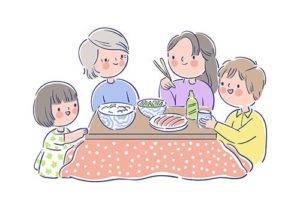How to Say Thanks Again in Japanese
The well-nigh common and natural way to say "thank you" in Japanese is the casual ありがとう (arigatou) or the formal ありがとうございます (arigatou gozaimasu).
Yous can utilise ありがとう (arigatou) or ありがとうございます (arigatou gozaimasu) as a means to express cheers for a gift, a compliment, a service or fifty-fifty to accept or refuse an offering in Japanese.
ありがとう (arigatou) is the nearly common casual way to say "thanks" in Japanese. You lot should refrain from using ありがとう (arigatou) when expressing thanks to anyone who is non your friend or family. This is because ありがとう (arigatou) is strictly a casual expression.
It would be considered rude If you were to use ありがとう (arigatou) with those who are of a higher social status than yourself, such as a teacher, manager, or even a shop assistant.
Therefore in scenarios where a brandish of politeness is necessary such as those listed above, it'due south natural to use ありがとうございます (arigatou gozaimasu).
With that said, there are enough of other ways to express thanks in Japanese outside of using ありがとう (arigatou).
In that location may be situations where yous wish to express more than than only "thanks" to someone. One example could be to attach 本当に (hontou ni) before ありがとう (arigatou) to make 本当にありがとう (hontou ni arigatou). This expression means "thank you very much" in Japanese.
The Japanese language is full of expressions that have unique implications and meanings that are absent-minded in English. For case, the term いただきます (itadakimasu) is an expression that's commonly used to express thanks earlier eating a meal.
This ultimate guide is tailored towards beginners and intermediate learners alike. All entries are accompanied with audio, examples and explanations for your reference!
Cheers in Japanese
- Thank you.
ありがとう。
arigatou.
The nigh common causal style to express your cheers to someone in Japanese is ありがとう (arigatou). It'south a non-complex discussion and at that place are minimal nuances.
Nevertheless, it should be noted that you lot should not use information technology to thank a stranger, manager, or anyone of a higher social status than yourself. This is because the Japanese linguistic communication has an extensive array of honorifics.
Despite your skillful intentions, it would be considered rude to say ありがとう (arigatou) to a cashier subsequently they've served you, for instance.
Therefore, the best time to use ありがとう (arigatou) is when you want to express thank you to someone you have an intimate relationship with. This could be a friend, classmate, or fifty-fifty a co-worker, depending on the context.
ありがとう (arigatou) Examples

You tin can utilize ありがとう (arigatou) by itself, yet, sometimes you may wish to exist a little more specific nearly what you're expressing your gratitude for.
- プレゼント、ありがとう!
purezento, arigatou!
Thanks for the present!
You'll find that short sentences in Japanese can exist enough to express what you want to say. Ofttimes, you won't need to add extra fluff to the sentence similar "for" and "the" in English.
Instead, simply stating the item, followed by ありがとう (arigatou) translates to "thank you lot for X". This formula cannot be applied to verbs.
If someone has been particularly helpful with a lot of things, you lot may wish to give thanks them with:
- いろいろ ありがとう。
iroiro arigatou.
Thank you for everything.
The word いろいろ (iroiro) in the in a higher place expression refers to "diverse" or literally to "a diverseness of things". You lot can utilize information technology to form sentences such every bit
- いろいろな本が好き。
iroiro na hon ga suki.
I like various books.
Related: How to say I Similar Y'all in Japanese [Ultimate Guide].
In the case of the showtime example "thanks for everything", the いろいろ (iroiro) functions similarly to the second instance. This means that a more literal translation of the first example would be "cheers for a variety of things".
With that said, いろいろありがとう (iroiro arigatou) is used to express your gratitude to someone for all the things (no matter how large or small) that they've done.
This is a generic mode of expressing your gratitude for "everything" someone has washed. There are more intimate ways to say this, see the entry #Thank you For Everything in Japanese, beneath.
Y'all tin can likewise make the expression more personal by proverb the name of the person whom you're thanking, followed by ありがとう (arigatou).
- [name]、ありがとう。
[proper noun], arigatou.
[name], thank yous.
Cheers for Everything in Japanese
Although y'all tin express "thank you for everything" in Japanese with いろいろありがとう (iroiro arigatou), explained higher up, sometimes yous may want to add together more emotion to your words.
- Thank yous for everything.
いつもありがとう。
itsumo arigatou.
When you use いつもありがとう (itsumo arigatou) y'all're expressing your gratitude for quite literally everything the person has washed for you.
This is because いつも (itsumo), the offset function of the expressions, translates as "e'er" or "all the time".
Nosotros know that ありがとう (arigatou) is a casual fashion of expressing general thanks in Japanese. Therefore when y'all tell someone いつもありがとう (itsumo arigatou) yous communicate that you appreciate the things that they're always doing for you.
You tin can pair the expression with other phrases to better communicate what you're grateful for or/and how it'due south made you lot feel. For case,
- 本当に嬉しい!いつもありがとう。
hontouni ureshii! itsumo arigatou.
I'm so happy! Cheers for everything.
Related: How to say Happy in Japanese [Ultimate Guide].
Thanks For Today in Japanese
- Give thanks y'all for today.
今日はありがとう。
kyou ha arigatou.
If you lot've had a especially enjoyable 24-hour interval with someone, you may wish to thank them for the experience. Y'all tin do this with 今日はありがとう (kyou ha arigatou), which as well makes an excellent parting phrase.
The commencement part of the expression, 今日 (kyou) is fabricated up of two kanji. 今 which means "now" and 日 which ways "24-hour interval". Combine them and yous get 今日 (kyou), the discussion for "today" in Japanese.
Post-obit 今日 (kyou) is は (ha), a Japanese grammar particle that marks the preceding substantive as the subject area of the sentence. Grammatically speaking, the は (ha) emphasises the 今日 (kyou) as the subject.
Finally, past attaching ありがとう (arigatou), you consummate the informal expression, 今日はありがとう (kyou ha arigatou).
You tin can pair the expression with remarks on why you're grateful. You could practice this by expressing how you experience. For example,
- 楽しかった!今日はありがとう。
tanoshikatta! kyou ha arigatou.
That was fun! Thank y'all for today.
If yous peculiarly enjoyed the twenty-four hour period, you could communicate how you'd like to hang out again.
- 今日はありがとう!また遊ぼう!
kyou ha arigatou! mata asobou!
Thank you for today! Permit's hang out again!
Yous may even wish to enquire someone directly how their 24-hour interval has been and if they've enjoyed information technology or not. To learn how to do so, visit the below recommended ultimate guide.
Recommended: How to say Accept a Farewell in Japanese [Ultimate Guide].
Thanks For Today (Formal)
There may also exist occasions where you wish to utilise this phrase in more than formal scenarios. Perchance you've only finished a training session with a manager at a chore and you wish to limited your cheers, for instance.
To practice this, you will need to apply honorific speech. This involves changing the expression to:
- 今日はありがとうございます。
kyou ha arigatou gozaimasu.
Thank you for today. (formal).
More than information on expressing gratitude politely in Japanese is explained in the accordingly titled entry beneath!
Thank You lot For That (Informal) in Japanese
When you want to give thanks someone for something that happened a few moments ago, there are two expressions yous can employ.
Give thanks You For That #i
The start is:
- Thanks for that.
さっき、ありがとう。
sakki, arigatou.
This expression incorporates ありがとう (arigatou), which we've established is the standard translation for "thank you".
The preceding word is さっき (sakki). This word is both a noun and adverb that conveys the meaning "a moment ago" or "just now". You use it when referring to an event that has recently happened. How recently, exactly, depends on the context.
If someone did y'all a favour for yous, only you didn't become a risk to properly give thanks them at the time, you can use this expression.
Thank you For That #2
The second is:
- You helped me/"I'm saved".
助かった。
tasukatta.
This expression is an indirect style to evidence your appreciation. Yous use it when you lot feel a sense of relief, or if someone "saved" you from a certain fate.
By using 助かった (tasukatta), you limited that you feel thankful for having been removed or saved from a situation or circumstance.
For example, your figurer could accept simply cleaved downwardly, and in that heart-breaking moment, you realise that all of your personal information may be lost. Luckily you lot have a friend who knows just how to solve the trouble – and they do just that!
You could say:
- [name] のおかげで助かった。
[name] no okagede tasukatta.
I'm saved cheers to [name].
Note that in the above instance, you lot should always refer to the person'due south actual name when you lot want to accost them as "you" in Japanese. Although there are ways to say "you", the near natural way is to phone call them by their proper noun, even if you're speaking to them direct.
It may exist even more advisable to combine the two expressions.
- さっきありがとう! 助かったよ!
sakki arigatou! tasukatta yo!
Thanks for that! Y'all helped/saved me!
The magic of Japanese is that even if y'all don't know the person's name, or if you don't experience like using it, you can drop the pronouns birthday and the sentence will remain natural.
Cheers For This in Japanese
- Thank you for this.
[te-class verb]くれてありがとう。
[te-form verb] kurete arigatou.
To express gratitude specifically for something that someone did for you, you'll need to utilise the to a higher place formation.
You lot need to use this formation when working with verbs. For case, perhaps you'd like to thank someone for inviting you to an event or party.
Offset, y'all'll need the verb for "invite" in Japanese, which is 誘う (sasou). Secondly, y'all'll need to transform information technology into the te-form, which makes information technology 誘って (sasotte). And then you tin insert information technology into the formation listed above. This would make:
- 誘ってくれてありがとう。
sasotte kurete arigatou.
Cheers for inviting me.
I capeesh that may have been a lot of information to take in. Here'south how it works.
Firstly, you lot can brand sentences with this formation using any verb. Secondly, that verb must ever be conjugated into the te-course.
The te-form is mayhap one of the outset challenging "forms" you'll see when learning Japanese. It is a grammatical conjugation pattern that has many uses. In this case, information technology lets us connect sequential actions together, something you can't do with verbs in Japanese unless you conjugate them!
I recommend this page for more data on how to conjugate the te-form, should you be interested.
Once the verb has been conjugated into the te-grade, you lot can then attach くれてありがとう (kuretearigatou) which volition allow you to thank someone specifically for what they've done.
くれて (kurete) Explanation
The magic in this expression happens with くれて (kurete), which is the te-form of くれる (kureru), a verb that doesn't quite have a literal English translation. The all-time way to understand くれて (kurete) would be to interpret it as a discussion that adds a subtle notion of "peculiarly" to the English expression "for me".
Although the nuance is different to the total touch of saying "especially for me" in English, similarities are present in the overall feeling of the meaning.
Therefore, when y'all utilise くれて (kurete), you're expressing that actress piddling sense of gratitude.
For case, yous could thank someone for accompanying you to a location.
- 一緒に行ってくれてありがとう。
isshouni itte kurete arigatou.
Thanks for going together with me.
Although the improver of 一緒に (isshouni) is also optional, it adds even more weight to the already unique expressiveness of くれて (kurete).
Thank you Too in Japanese
At that place are 2 means to express "thank you" back to someone who has merely said it to you. The first way is to use the post-obit sentence structure:
- [name]もありがとう。
[proper noun] mo arigatou.
Thank you as well.
As previously highlighted, when you want to refer to someone every bit "you" in Japanese, it's always all-time to use their bodily name. Therefore, you begin this phrase by stating their name.
The concluding office of the phrase is ありがとう (arigatou), the standard style to communicate thanks in Japanese. The fundamental divergence with here though, is the inclusion of も (mo) betwixt the person'southward name, and the word ありがとう (arigatou).
This も (mo) is a Japanese grammer particle that means "too".
Combining all three elements makes the complete phrase. To formalise it, extend ありがとう (arigatou) to ありがとうございます (arigatou gozaimasu).
Cheers To Y'all Too in Japanese
The second manner to thank the thanker dorsum is to utilise the following phrase:
- Thanks to you too.
こちらこそありがとう。
kochirakoso arigatou.
When you say the above phrase as a response to someone who has just thanked you, you're emphasising that you lot're the one who should be thanking them.
Essentially you're maxim "no, thank yous!", or "I'k the ane who should be thanking you" in Japanese.
This phrase can also be formalised by changing the ありがとう (arigatou), to ありがとうございます (arigatou gozimasu).
Thanks in Japanese

- Thank you.
どうも。
doumo.
Although they are both a statement of gratitude, generally, "thank you lot" is considered to be slightly more than formal than "thanks".
The same applies to Japanese with ありがとう (arigatou) meaning "thank you", and どうも (doumo), significant "thanks".
どうも (doumo) is marginally informal compared to ありがとう (arigatou). Therefore どうも (doumo) is the best way to express "thanks" in Japanese.
Another departure between the two is that ありがとう (arigatou) carries slightly more "emotional impact" or earnestness compared to どうも (doumo). For this reason, it'south better to utilize ありがとう (arigatou) when saying "thanks" to your friends. Using どうも (doumo) in these situations could exist considered a footling rude, depending on the person.
On the other hand, it'south natural to employ どうも (doumo) equally a casual response to a cashier at a convenience store who has just thanked you with the formal ありがとうございます (arigatou gozaimasu).
- どうもありがとうございます。
doumo arigatou gozaimasu.
Cheers so much. (formal).
You tin, yet, combine どうも (doumo) and ありがとう (arigatou) together to make the phrase どうもありがとう (doumo arigatou), which would hateful "thank you so much" in Japanese.
The improver of ございます (gozaimasu) in the example sentence higher up, makes the expression formal. This is further explained in the entry below!
Thank You in Formal Japanese

- Thank you (formal).
ありがとうございます。
arigatou gozaimasu.
Equally mentioned, the Japanese language has many honorifics that require you to speak with unlike levels of politeness, depending on who you're speaking to.
The way y'all do this with "thank you" in Japanese is to take the standard way to express gratitude, ありがとう (arigatou) and extend it to ありがとうございます (arigatou gozaimasu).
Yous will be expected to employ the formal ありがとうございます (arigatou gozaimasu) to communicate your thanks to strangers, teachers and managers. For instance, when saying thank you lot to shop staff, y'all'll desire to apply ありがとうございます (arigatou gozaimasu), rather than ありがとう (arigatou), which would be considered rude.
Proverb ございます (gozaimasu) is also necessary when saying "good morning time" to someone formally in Japanese, which is おはようございます (ohayou gozimasu).
I recommend this video that explains the nuances of ございます (gozaimasu) in other words.
Thank You lot Very Much in Formal Japanese
- Thank you very much (very formal).
誠にありがとうございます。
makotoni arigatou gozaimasu.
Perhaps the about polite way to express gratitude in Japanese is with the above phrase. Information technology is an exceptionally sincere way of saying thank you, and you'll almost likely hear this from retail workers when speaking with customers, or from a company to their clients/viewers or customers.
As this is an expression that's reserved for occasions when a high level of politeness is required, the words that you lot would typically find paired with it are also that of Keigo (honorific spoken language).
For instance, the discussion for "today" in Japanese is 今日 (kyou). Therefore the casual way of saying "thank you for today" in Japanese is:
- 今日はありがとう。
kyou ha arigatou.
Cheers for today.
It's most natural to utilize the above expression with friends and family unit.
To increase the politeness, you can use:
- 今日はありがとうございます。
kyou ha arigatou gozaimasu.
Thank you for today.
This addition of ございます (gozaimasu) adds a considerable amount of formality. Y'all can employ this with managers, teachers or strangers.
The terminal, and almost polite version would be:
- 本日は誠にありがとうございます。
honjitsu ha makotoni arigatou gozaimasu.
Thanks for today.
Firstly, not only does the addition of 誠に (makoto ni) add more overall weight to the expression, simply 今日 (kyou) changes to 本日 (honjitsu).
The reason for this change is that essentially, 本日 (honjitsu) is a much more formalised version of 今日 (kyou). Y'all'd typically hear this phrase being used by a business to thank their clients or customers, whom they wish to treat with the utmost respect.
Hence, you'll most likely hear 誠にありがとうございます (makoto ni arigatou gozaimasu) paired with unfamiliar words that are infrequently used exterior daily chat.
Thanks Very Much in Japanese

- Thank you very much.
本当にありがとう。
hontouni arigatou.
The expression 本当にありがとう (hontouni arigatou) has dissimilar nuances compared to other ways to communicate a deep thanks. The reason being is that the offset office of the expression, 本当に (hontouni) is a give-and-take that means "really" or "truly".
Therefore when you say 本当にありがとう (hontouni arigatou) to someone, you communicate an exemplified genuine expression of gratitude.
In other words, during situations where y'all feel you are truly grateful for something you tin can express this with 本当にありがとう (hontouni arigatou).
- いつもそばにいてくれるね。本当にありがとう。
itsumo soba no itekureru ne. hontouni ni arigatou.
You're always there for me. Thank yous and so much.
This expression is also a fantastic one to use when receiving a heartwarming gift from someone. For instance:
- 結局買ってくれたんだ。本当にありがとう!
kekkyoku katte kuretanda. hontouni arigatou!
You (kindly) bought it for me after all. Give thanks you so much.
To sum up, you tin use 本当にありがとう (hontouni arigatou) to express a heartfelt thanks in Japanese.
Responding to Thank You lot in Japanese
One of the all-time means to respond to someone when they say "thank yous" in Japanese is to say "no problem".
I've composed an ultimate guide that details all the possible ways y'all tin express this, here's the link!
How to say No Problem in Japanese [Ultimate Guide].
Y'all're Welcome in Japanese
Perhaps the safest and standard way to respond to someone else'due south expression of thanks is to say "you're welcome".
- You're welcome.
どういたしまして。
douitashimashite.
You tin can reply to ありがとう (arigatou) with どういたしまして (douitashimashite), which is the same equally replying with "you're welcome" to "thank you".
Although this expression is generally formal, y'all can use information technology in casual situations to communicate a sincere "yous're welcome" to friends and family unit.
A typical conversation may flow like this:
- パソコンのことを手伝ってくれてありがとう。
pasokon no koto wo tetsudatte kurete arigatou.
Thanks for helping me with my computer.
The answer:
- どういたしまして。いつでもいいよ。
douitashimashite. itsudemo ii yo.
You're welcome. Anytime.
I Capeesh It in Japanese
- I capeesh information technology.
感謝します。
kansha shimasu.
To limited feelings of gratitude outside of the bounds of ありがとう (arigatou), you tin use the formal 感謝します (kansha shimasu) or the casual 感謝する (kansha suru).
The word 感謝 (kansha) means "gratitude" or appreciation in Japanese. There are two kanji that brand up this expression. Firstly, 感, which ways "feeling" or emotion". This kanji is then followed by 謝 which means "thanks" or "apologise".
Quite literally, the significant of 感謝 (kansha) can be understood as "a feeling to apologise". This is considering Japan and Japanese are both polite culturally and linguistically. Therefore, when you thank someone with 感謝 (kansha), you're expressing an amends for the inconvenience that you may have caused them.
Notwithstanding, yous tin apply 感謝します (kansha shimasu) in a wide assortment of situations; at a time when you wish to communicate that you lot appreciate something that someone has done for you lot.
For instance, you lot could attach more emotion to the expression and go far into the phrase:
- 心の底から感謝します。
kokoro no soko kara kansha shimasu.
I appreciate you lot from the lesser of my centre.
Remember that you're absolutely fine to omit pronouns in vernacular Japanese you lot'll sound more than natural if y'all do! For that reason, although the in a higher place phrase lacks any pronouns, when it is directed from one to another, context is articulate enough to allow the omission.
Using すみません (sumimasen) to Express Thanks
- I'thou sorry (cheers).
すみません。
sumimasen.
すみません (sumimasen) is a formal word that means "excuse me" in Japanese. Typically, you lot would use information technology when trying to catch someone's attention. This could exist when you want to enquire a store assistant for some assistance, or when you lot'd like to initiate a conversation with a stranger, for instance.
Yet, you lot tin likewise use すみません (sumimasen) to express a form of gratitude in Japanese. A not bad example of this is when yous discover yourself on a crowded train and are trying to make your way to the exit as you lot have reached your stop. The sheer number of people is making this difficult to practise then. So, equally you lot're hastily making your (non-forceful) way through, it would be polite to say すみません (sumimasen) a few times.
Let'southward expect at another example! Yous find yourself busy at work. However, lucky for you, your kind co-worker has offered to complete some of the work on your behalf. In this situation, you would be amend off using すみません (sumimasen), rather than simply ありがとうございます (arigatou gozimasu). The reason for this is that すみません (sumimasen) is considerably more than humbling.
- すみません。お願いします。
sumimasen. onegai shimasu.
Cheers. Aye, please.
By using すみません (sumimasen) to limited your thanks, it'southward as if yous're saying "I'm sorry for this, merely thank you" all in a unmarried word.
More Ways to Express Thank you in Japanese
- Give thanks you.
サンキュー。
sankyu-.
The Japanese discussion サンキュー (sankyu-) derives from the English language word "thanks", hence the similarities in pronunciation. Unlike the English word, though, サンキュー (sankyu-) is considered to exist a casual expression.
Therefore, you lot should use サンキュー (sankyu-) when speaking with friends, family, or those you have an intimate connexion with. Furthermore, the word may come across as somewhat playful, so, during serious conversations, yous may be better of sticking with ありがとう (arigatou) instead.
Interestingly, the word サンキュー (sankyu-) too happens to accept the aforementioned phonetics as the numbers three and 9 when spoken in Japanese. The pronounciation for the number iii, being さん (san), and nine beingness きゅう (kyuu).
For this reason, you lot may encounter some interesting takes on the numbers three and ix, that when put together, can represent サンキュー (sankyu-) in Japanese.
No Thank you in Japanese
There are a number of ways you can express "no thank you" and decline someone'southward offering or request in Japanese.
Very Formal No Cheers
- No cheers (formal).
結構です。
kekkou desu.
The word 結構です (kekkou desu) is the nearly formal and straight way to limited "no thank you" in Japanese.
Being quite a directly word, it can come up across as quite edgeless or abrupt if used during the wrong scenarios. Thus, using information technology when you demand to convey precisely that you are declining something is recommended.
It has the dash of "I'thou skillful, no thanks".
For instance, perhaps a shop banana is advertizing a product to yous. To land that y'all practice non desire it, you can say:
- 私は結構です。
watashi ha kekkou desu.
No cheers, I am good.
Interestingly, y'all can pair 結構です (kekkou desu), pregnant "no give thanks yous with ありがとうございます (arigatou gozimasu) meaning "thank you". Hither's how information technology works.
Equally mentioned, the subject of sentences in Japanese can exist dropped. This means that if you are asked if you'd like something, you could first respond with but 結構です (kekkou desu) which would convey the significant of "no thank you lot".
Following up with ありがとうございます (arigatou gozimasu) afterwards would then tell the other person that you lot're grateful for their assist.
- 結構です。ありがとうございます。
kekkou desu. arigatou gozaimasu.
I'm good (no thanks). Thank you (for your help).
Torso language is also important in Japanese culture, bowing and other etiquettes can go a long way when wanting to be polite.
Formal No Cheers
A slightly less formal mode to limited "no thank you lot" in Japanese, and the manner I personally prefer using is to use is the following phrase:
- 大丈夫です。
daijoubu desu.
Information technology'south okay.
I fully explain the ins and outs of expressing "okay" in Japanese in this ultimate guide.
In brusque, 大丈夫です (daijoubu desu) is a much more than friendly, still polite fashion to express that you don't demand or want something in Japanese. The expression 大丈夫です (daijoubu desu) is extremely flexible and can be used in a plethora of situations.
For example, a cashier may ask you if yous'd like a plastic purse at the convenience store. You could say:
- 袋は大丈夫です。
fukuro ha daijoubu desu.
Don't worry about the bag.
Of class, replying simply with 大丈夫です (daijoubu desu) would also exist sufficient.
Equally another case, imagine you're at a restaurant and the waiter asks if you'd like a refill on your drink. You lot could reply:
- 私は大丈夫です。
watashi ha daijoubu desu.
I'thou okay.
Past itself, 大丈夫です (daijoubu desu) has many meanings. These include "no thank you", "I'm adept", "okay", hence the wide diversity of uses.
Casual No Give thanks Y'all
You may also wish to express "no thanks" casually in Japanese, such as when speaking with friends. To do this, you can but remove the です (desu) and say:
- 大丈夫。
daijoubu.
It's okay.
It'due south besides worth noting that equally you don't demand to specify pronouns in Japanese, only saying 大丈夫 (daijoubu) tin can mean both "I'm okay" or "it's okay". Which significant is existence referred to, can usually be understood from the context.
Thanks For The Repast in Japanese

- Thanks for the repast.
いただきます。
itadakimasu.
The above phrase is often said before eating a repast in Japan. It is similar to saying grace, however, there is much more to this word that can't be justified in a single translation.
The literal meaning of いただきます (itadakimasu), is "I humbly accept it", withal in that location is an underlying sense of gratitude to be felt with these powerful words.
When you say いただきます (itadakimasu), yous're emphasising your gratitude for the source of the food and meal entirely. You laurels those who were involved in making the meal a reality, non just the melt, but the farmers, fishermen, merchants – everyone and everything.
For that reason, while reciting the phrase, some people will clasp their easily together, occasionally grasping the chopsticks with their thumbs and endmost their eyes.
Thanks For Your Piece of work Today
- Good work today/thanks for your piece of work.
お疲れ様です。
otsukaresama desu.
The to a higher place phrase is ofttimes used to give thanks someone for their hard piece of work. Yous can utilize it in the workplace with colleagues, or you can fifty-fifty say information technology to a friend who has just finished a study session.
You have reached the end of this ultimate guide! お疲れ様です!(otsukaresama desu).
There are, of class, many more nuances to this expression. You tin find the total explanation and a list of synonyms in this ultimate guide, that details how to say "Practiced Job" in Japanese.
Or, if you fancy browsing through the collection of How-to Japanese Ultimate Guides, you tin can find a link here:
More Ultimate How-to Japanese Guides
How to Say Thanks Again in Japanese
Source: https://thelanguagequest.com/thank-you-in-japanese/